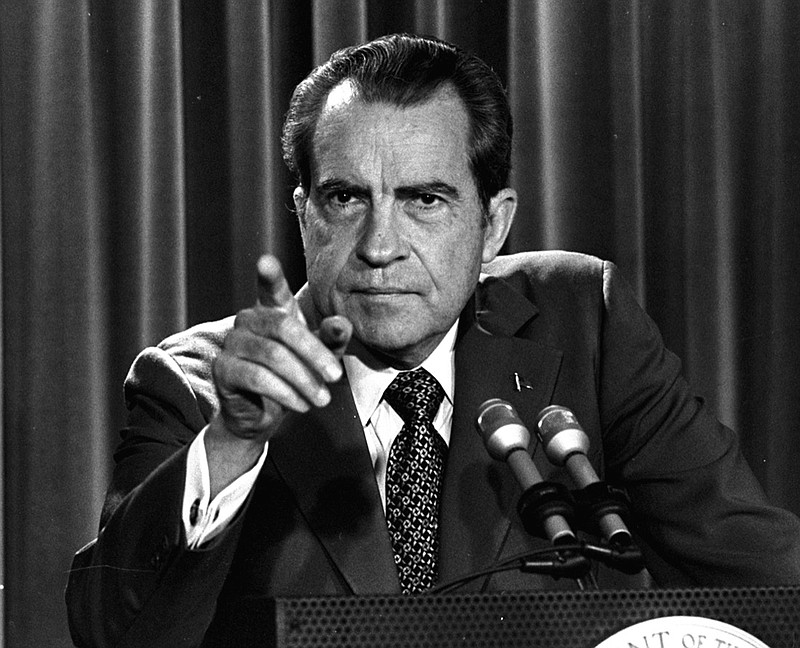Fifty years ago this week, just as it is this year, Tennessee was seen as a key state in national politics.
This year, polls say a U.S. Senate seat in the state is up for grabs in what already is a closely divided Senate. Although the Volunteer State has become reliably Republican, the relative popularity of a former two-term, moderate Democratic governor has given Democrats a shot at winning the state and potentially controlling the Senate.
A half century ago, Tennessee was seen as critical in the presidential sweepstakes. Although practically all statewide officeholders were Democrats, the state nevertheless had voted - barely - for Republican Dwight Eisenhower in 1952 and 1956 and - solidly - for Richard Nixon in 1960. It also had given Republican Barry Goldwater a strong 44.5 percent of the vote in 1964 and then had, shockingly to many observers, elected Republican Howard Baker to the U.S. Senate in 1966.
That's why Nixon, the Republicans' presidential candidate once again, had scheduled a campaign appearance in Chattanooga on Sept. 27, 1968.
"To Nixon and campaign staffers," reads "Nixon's Comeback," an article on the website of the Richard Nixon Foundation, "the [polling] numbers were strong but a cause of uneasiness."
By that time, the former U.S. vice president had resigned himself that he was not going to win all the states in the Deep South.
Segregationist former Alabama Gov. George Wallace had softened his block-the-school doorway stances, but his support of law and order, unions, minimum-wage laws and more localized government still resonated there.
Indeed, though no one knew it at the time, the American Independent Party candidate had reached the high water mark of his candidacy. In Gallup's Sept. 20-22 poll, he had fully 21 percent national support. He had commanding leads in Alabama, Louisiana and Mississippi and lesser ones in Arkansas, Georgia and North Carolina. He had been gaining on Nixon in Florida, South Carolina and Tennessee.
Had Wallace won all those states, the election almost assuredly would have prevented any candidate from gaining an electoral majority and would have sent the race to the U.S. House.
The former Alabama governor had been in Chattanooga for a rally in late July, according to an Aug. 27, 2018, article in the Montgomery Advertiser recalling the chaotic campaign. And he had no shortage of cheering supporters. One was a Baptist preacher who had a definitive stance on the third-party candidate.
"Outside the visible return of Jesus Christ," he said, "the only salvation of the country is the election of George Wallace."
Indeed, Wallace had nearly filled the auditorium for two previous campaign appearances, according to Times Free Press archives.
That's why Nixon had scheduled the noon rally in the Scenic City, at Memorial Auditorium. He couldn't lose Tennessee - or any other Southern state not in the Deep South - and hope to find a path to victory.
"[S]ome observers have credited the apparent Wallace strength in this area with enticing the candidate himself to come here," Bill Casteel wrote in The Chattanooga Times on the day of the event, "rather than sending his vice presidential running mate, Gov. Spiro Agnew."
Of course, it was not supposed to be that way. Nixon came out of the early August Republican National Convention with a 16-point Gallup poll lead over Vice President Hubert Humphrey, who would be nominated in the riot-filled Democratic National Convention later that month. The GOP was set to focus its strategy on what its candidate called the "Big Seven" - California, Illinois, Michigan, New York, Ohio, Pennsylvania and Texas.
Nixon, meanwhile, had been to Chattanooga before, but he was no regular visitor. As a newly minted, second-term congressman, he'd been given an award by the Jaycees at the Read House on Jan. 21, 1948. And he campaigned here for Goldwater at Memorial Auditorium in 1964.
The full auditorium for his visit in 1968 may have portended the state's vote, but the candidate made sure the crowd of 5,000 (with thousands more standing outside) understood the stakes.
"You had better make up your mind," he said, without mentioning Wallace, "whether you want to play a part in shaping the kind of government you'll have for the next four years. The choice is clear. The Democratic or the Republican candidate is going to win - and America can't afford four more years of what they have had!"
Before entering the auditorium, he had told the cheering throng of thousands who couldn't get in, "I can tell by this crowd that we're going to carry Tennessee."
Nixon, in fact, did get the state's 11 electoral votes, outpolling Wallace by 3.83 percent, the closest margin over Wallace in any state the president-elect won. And while he won a fairly significant national electoral vote majority, he won the popular vote by a little more than 500,000 votes.
Late last week, the Real Clear Politics Senate map, based on recent polls, predicted the post-election Senate makeup to remain the same, 51 Republicans and 49 Democrats (or independents who caucus with Democrats). Its poll average of the Tennessee Senate race showed a tie, indicating things are still clearly fluid in the Volunteer State and across the country.
Tennessee, just as it did 50 years ago, will have a significant part to play in who governs the nation.
